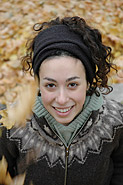In focus
Erica Zelfand: Hiking against hunger

Rachel Granofsky
The Appalachian Trail has already changed McGill student Erica Zelfand, and she hasn't even started yet. What began as a whimsical idea has turned into an imminent reality for which Zelfand and her boyfriend-cum-hiking partner Timothy Crespi are preparing in Boulder, Colorado. Hard at work acquiring gear and food, they take frequent training hikes in the mountains to get their minds and bodies ready for the physical and mental challenge of hiking roughly 3500 km. So far, Zelfand has gained five pounds of muscle and a considerable amount of endurance.
Zelfand and Crespi will start hiking on March 1, walking 24 to 32 km a day so that they can finish in time to start school again in September. March weather in Georgia, where they'll start from, is cold and snowy, and their packs will be heavy with winter gear: synthetic-fill sleeping bags, a three-season tent, snowshoes. They plan to hike every day for five months through three seasons and 14 states, stopping periodically in towns to restock their food supplies.
People hike long trails like the Appalachian Trail and the Pacific Crest Trail, its Western counterpart, for all kinds of reasons: to commune with nature, to get in shape or just so that they can say they have done it. Bill Bryson popularized the Appalachian Trail with his comical account A Walk in the Woods, in which he concludes that hiking the trail gave him, among other things, more respect for wilderness and nature.
But Zelfand seeks not only personal change. After participating in a workshop focusing on third-world debt and global hunger, she realized that she could use her trip to benefit others. She has given her walk in the woods a social purpose, and it has become a Hike Against Hunger. She says, "The idea of a fundraiser validated the idea of hiking the trail. It became a plan, not an idea." She is soliciting donations for Action Against Hunger, an international non-profit organization that provides both emergency food aid as well as long-term projects to help communities in the developing world become self-sufficient.
Zelfand hopes that her hike will also raise awareness of world hunger. "If you are from North America you have to be two things: grateful and willing to take on responsibility. There's a responsibility, being born into comfort, to look out for others."
She will symbolically carry her sponsors with her as she hikes; each sponsor's name will be written on one of the 108 beads of a Buddhist prayer garland, a mala. To Zelfand, the mala represents "the unity of my sponsors and myself, and reminds me that they believe in me." Although 90 percent of would-be through-hikers drop out, she is confident that the combination of her own enthusiasm for the outdoors and her altruistic goal will keep her on the trail.
Zelfand is taking the winter semester off from her double major in religious studies and english. When asked why she couldn't wait until she finished school to hike the trail, she says, "It's a once in a lifetime opportunity, and once in a lifetime opportunities can't wait.
"It's so soon," she says. "But every time I get nervous about it, I remind myself how much fun it will be. It's going to rock." Two weeks from now, she will be on the trail with nothing but sky, trees and over 2,000 miles ahead of her.
To learn more, visit www.hikeagainsthunger.com, and read Erica's and Tim's trail journal at hikeagainsthunger.blogspot.com.
Hana Askren
 |
||||
|
Can Montreal become New York? No. But it can do things at its own level very well, and I think Florida is right to point to the things that Montreal has as assets, that we shouldn't spoil, that we should bank on and develop. |
||||
Our heritage, our hockey
Picking up three credits for a course called Sports in Canada sounds, as golfers say, like a gimme, so it is no surprise that Professor Jack Jedwab's rookie course under the McGill Institute for the Study of Canada quickly reached its 50-student cap and is on the calendar for 2005—2006. It is not, however, easy academic pickings.

Tzigane
"It's a multidisciplinary course addressing sports from a wide variety of standpoints," says Jedwab in a crowded Leacock Building office borrowed from a sociology professor. "It looks at the construction of Canada's sports history, then at various issues in sports."
From an initial demographic survey of the sports Canadians watch and play, the course moves on to diversity, ethics, drugs and violence, public policy, fitness and other topics. It is something of a crusade for Jedwab, who is the executive director of the Association for Canadian Studies.
"McGill has provided an important opportunity to address the idea that sports is a part of Canadian studies. Many scholars don't make the connection. There's very little mention of sport in history texts, which doesn't do justice its role in our history."
He notes that the government recognizes the subject as a thread of national identity by situating Sports Canada within Heritage Canada. On February 10, Gaétan Robitaille, director of Sports Quebec, and Joanne Kay, a senior advisor to Sports Canada will explain government's fundamental role in sports and people involved in sports. As an example, Jedwab points to high levels of sports volunteerism as important to citizenship.
The course includes business, professional-versus-amateur, media and labour issues, leading to questions about the current NHL lockout.
"In some ways, people were conditioned because it's happened in other sports and the performance of some hockey teams hasn't been as extraordinary as it was years ago. That's reflected in studies I've done that show the popularity of hockey in Montreal has dropped considerably in the past 20 years.
"For many years, Canadians were frustrated watching Olympic teams without our best performers. Now that we're able to send our finest team to the Olympics, a lot of Canadians feel better about it. The Junior World Championships did well with TV viewers. There's a definite connection with performance. Every poll I've done so far demonstrates that sports is a very important part of how Canadians define themselves."
From the first intercollegiate football game and first organized hockey team in the 1870s, through to the first athletics director James Naismith, inventor of basketball, to the founding of the McGill Sports Hall of Fame in 1996, Jedwab believes that McGill's sports tradition creates an ideal environment for his course.
As he feels his way through its first year, he acknowledges, as most professors do, that he has learned much from his students. A discussion of gender issues, for example, produced questions about increased female participation modifying rules so that men's and women's games more closely resemble each other. Jedwab turned that into a class research project.
"It's a bit of an experiment. It's being built, a field of dreams, and they will come."
 |
||||
|
Changing a name by itself may not seem earth-shattering, but it reflects an important change in knowledge. |
||||
